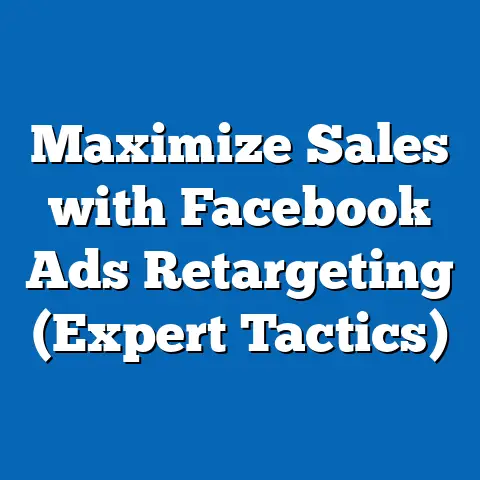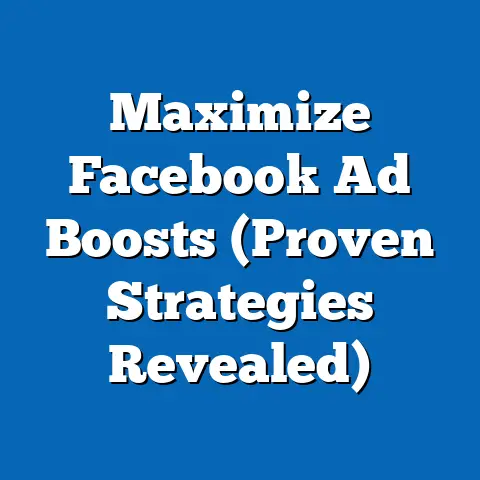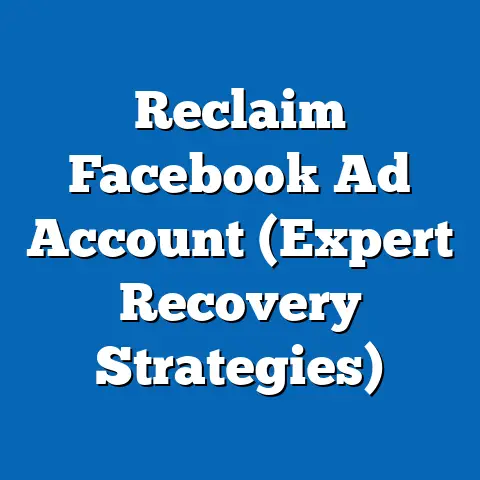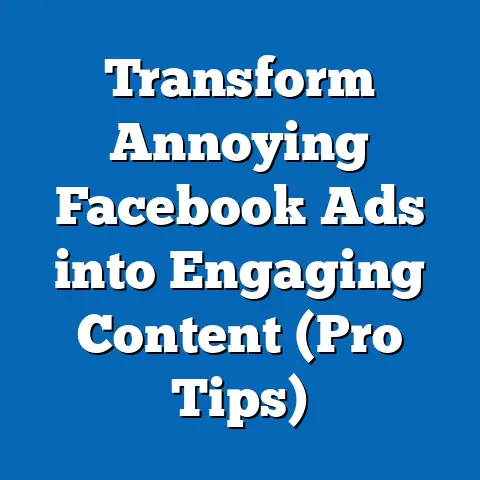Optimal Facebook Ad Size Revealed (Essential Design Tips)
In the rapidly evolving world of digital marketing, the visual appeal and structural design of advertisements play a pivotal role in capturing audience attention. Among the myriad platforms available, Facebook remains a dominant force, with over 2.9 billion monthly active users as of 2023, according to Statista. Within this vast digital ecosystem, the aesthetics of an advertisement—encompassing its size, layout, color scheme, and imagery—can significantly influence user engagement and conversion rates.
This article delves into the optimal Facebook ad sizes and essential design tips, beginning with an exploration of aesthetics as a cornerstone of effective advertising. We will examine the historical context of digital ad design, the societal implications of visual trends, and the data-driven insights that reveal the most effective ad dimensions. By combining qualitative analysis of design principles with quantitative research on performance metrics, this comprehensive study aims to equip marketers with actionable strategies for creating visually compelling and high-performing Facebook ads.
Section 1: Aesthetics in Digital Advertising – Defining Characteristics and Importance
Aesthetics in digital advertising refers to the visual and sensory elements that shape a viewer’s perception of an ad. Key characteristics include color harmony, typography, image quality, and spatial arrangement, all of which contribute to an ad’s ability to stand out in a crowded digital space. On platforms like Facebook, where users scroll through an endless stream of content, an ad’s aesthetic appeal often determines whether it garners a fleeting glance or a meaningful interaction.
The importance of aesthetics lies in its psychological impact. Studies, such as those conducted by the Nielsen Norman Group, indicate that users form opinions about visual content within 50 milliseconds of exposure. This split-second judgment underscores the need for ads to be visually striking and intuitively designed to evoke emotions or convey messages effectively.
Beyond immediate engagement, aesthetics also influence brand perception. A well-designed ad with cohesive visuals can enhance brand recognition and trust, while a poorly executed design risks alienating potential customers. As we explore optimal ad sizes, it’s critical to remember that size and aesthetics are intertwined—dimensions dictate how visual elements are displayed, impacting the overall user experience.
Section 2: Historical Context of Digital Ad Design
The evolution of digital advertising aesthetics mirrors broader technological and cultural shifts. In the early days of the internet during the late 1990s and early 2000s, banner ads dominated online spaces with rudimentary designs—often static images with minimal text due to slow internet speeds and limited display technologies. These ads prioritized functionality over visual appeal, constrained by pixelated graphics and small file size requirements.
The launch of social media platforms like Facebook in 2004 marked a turning point. By 2007, when Facebook introduced its advertising platform, marketers began experimenting with more dynamic formats, including images and interactive elements. The rise of smartphones in the late 2000s further revolutionized ad design, as mobile-first aesthetics demanded responsive layouts and thumb-friendly navigation.
Over the past decade, the emphasis on aesthetics has intensified with the advent of high-resolution displays and faster internet speeds. Video ads, carousel formats, and immersive storytelling have become staples of Facebook advertising, reflecting a societal shift toward visual consumption. This historical trajectory highlights how ad design has adapted to technological advancements and changing user expectations, setting the stage for today’s focus on optimal ad sizes and refined aesthetics.
Section 3: Societal Implications of Visual Advertising Trends
The aesthetics of Facebook ads do not exist in a vacuum; they reflect and influence societal values and behaviors. In an era of information overload, visually appealing ads cater to shorter attention spans, aligning with a culture of instant gratification. This trend has societal implications, as it prioritizes surface-level engagement over deeper content, potentially shaping how individuals process information.
Moreover, the push for personalized and visually tailored ads raises questions about privacy and consumerism. As algorithms analyze user data to deliver aesthetically customized content, there’s a fine line between effective targeting and invasive surveillance. A 2022 Pew Research Center survey found that 74% of social media users are concerned about how platforms use their data for advertising purposes, highlighting a tension between aesthetic innovation and ethical considerations.
On a positive note, aesthetically driven ads can foster inclusivity by showcasing diverse representations in imagery and messaging. Brands that prioritize authentic visuals resonate with younger generations like Gen Z, who value social responsibility, according to a 2021 McKinsey report. Thus, the societal impact of ad aesthetics extends beyond marketing metrics, influencing cultural norms and consumer expectations.
Section 4: Optimal Facebook Ad Sizes – Data-Driven Insights
Transitioning from the broader context of aesthetics, let’s focus on the specifics of Facebook ad sizes, which are critical to maximizing visibility and engagement. Facebook offers a variety of ad formats, each with recommended dimensions to ensure optimal display across devices. These sizes are not arbitrary; they are informed by extensive testing and user behavior data to balance visual impact with platform constraints.
4.1 Single Image Ads
The single image ad, one of the most common formats, is recommended at a size of 1200 x 628 pixels for News Feed placements, with a minimum of 600 x 600 pixels. This dimension ensures clarity on both desktop and mobile screens, where most users access Facebook. According to a 2023 study by Hootsuite, ads adhering to these dimensions achieve up to 20% higher click-through rates (CTR) compared to non-optimized sizes, as they avoid cropping or distortion.
4.2 Video Ads
For video ads, Facebook suggests a resolution of at least 1080 x 1080 pixels for square formats and 1080 x 1920 pixels for vertical formats, aligning with mobile-first viewing habits. Videos that match these dimensions tend to retain viewer attention longer, with a 2022 Meta analysis reporting a 15% increase in watch time for properly sized content. The rise of vertical video, driven by platforms like Instagram Stories (also owned by Meta), underscores the importance of adapting to user preferences for full-screen experiences.
4.3 Carousel Ads
Carousel ads, which allow multiple images or videos in a swipeable format, perform best at 1080 x 1080 pixels per card. This square format maximizes real estate on mobile devices, where 98% of Facebook users access the platform, per a 2023 eMarketer report. Carousel ads with consistent sizing across cards also maintain visual coherence, enhancing the storytelling aspect that drives engagement.
4.4 Stories Ads
Facebook Stories ads, designed for ephemeral content, require a vertical format of 1080 x 1920 pixels to fill the screen without black bars. These ads cater to the immersive, full-screen trend popularized by younger demographics, with Meta reporting that Stories ads achieve 30% higher engagement rates when sized correctly. This format’s success reflects a societal shift toward quick, visually dominant content consumption.
4.5 Collection Ads
Collection ads, often used for e-commerce, combine a cover image or video with smaller product images, ideally at 1200 x 628 pixels for the main visual. This format leverages visual hierarchy to draw users into a curated shopping experience. Research by Socialbakers in 2022 found that collection ads with optimized sizes result in a 25% higher conversion rate compared to inconsistently sized visuals.
These data points emphasize that optimal ad sizes are not just technical specifications but strategic tools. They ensure that aesthetic elements are displayed as intended, preserving the ad’s visual impact and effectiveness across diverse devices and user contexts.
Section 5: Essential Design Tips for Facebook Ads
Beyond size, the design of Facebook ads requires a nuanced approach to aesthetics that aligns with user psychology and platform dynamics. Below are evidence-based tips to enhance ad performance, grounded in research and industry best practices.
5.1 Prioritize Visual Hierarchy
Effective ads guide the viewer’s eye through a clear hierarchy of information—typically from a striking visual to a concise headline and a compelling call-to-action (CTA). Use bold imagery or vibrant colors at the top of the ad to capture attention, followed by minimal text (Facebook recommends keeping text under 20% of the image area to avoid delivery restrictions). A 2021 study by AdEspresso found that ads with a strong visual hierarchy achieve 18% higher CTRs, as they reduce cognitive load for users.
5.2 Leverage Color Psychology
Color plays a pivotal role in evoking emotions and driving action. Warm tones like red and orange can create urgency, ideal for limited-time offers, while cooler tones like blue instill trust, suitable for professional services. According to a 2022 HubSpot report, ads using brand-consistent colors see a 33% increase in recognition, highlighting the need to align aesthetics with identity while experimenting with psychologically impactful hues.
5.3 Optimize for Mobile-First Viewing
With mobile users dominating Facebook’s audience, designs must prioritize thumb-friendly navigation and legible text on smaller screens. Use high-contrast elements to ensure visibility, and place CTAs in easily tappable areas, such as the bottom center of the ad. Meta’s 2023 mobile optimization guide notes that mobile-optimized ads achieve 27% higher engagement rates, underscoring the societal shift toward on-the-go consumption.
5.4 Incorporate Dynamic Elements
Static images are effective, but dynamic content like videos or animations often outperforms them. Short, auto-playing videos (under 15 seconds) with captions cater to users who browse without sound, with a 2022 Sprout Social study showing a 48% increase in engagement for video ads. Dynamic elements align with modern expectations for interactive, fast-paced content, especially among younger generations.
5.5 Test and Iterate with A/B Testing
Aesthetic preferences vary across demographics, making A/B testing a critical tool for refining designs. Test variations in color, imagery, and text placement to identify what resonates with your target audience. Data from WordStream (2023) indicates that advertisers who regularly A/B test their ads see a 30% improvement in ROI, emphasizing the value of data-driven design decisions over assumptions.
These tips, when paired with optimal ad sizes, create a synergy between form and function. They reflect an understanding of both technological constraints and cultural trends, ensuring ads are not only visually appealing but also strategically effective.
Section 6: Technological, Economic, and Cultural Influences on Ad Design
The design of Facebook ads is shaped by a confluence of factors beyond aesthetics, including technological advancements, economic pressures, and cultural shifts. Technologically, the proliferation of high-resolution screens and 5G connectivity has raised the bar for visual quality, enabling richer formats like 4K video ads. However, this also increases production costs, creating economic challenges for small businesses with limited budgets.
Economically, the competitive nature of digital advertising drives innovation in design. With Facebook’s average cost-per-click rising to $1.72 in 2023 (per WordStream), marketers must maximize ROI through visually optimized ads that cut through the noise. This economic imperative often pushes brands to adopt trending aesthetics, sometimes at the expense of originality, as seen in the overuse of minimalist designs in recent years.
Culturally, ad design reflects generational preferences and societal values. Gen Z and Millennials, who prioritize authenticity and social impact, respond better to ads with relatable imagery and transparent messaging, according to a 2022 Deloitte survey. Meanwhile, older generations like Baby Boomers may value clarity and directness over trendy visuals, highlighting the diversity within audiences that designers must navigate.
These influences underscore the complexity of ad design as a field that intersects with broader systemic forces. Optimal sizes and aesthetic choices are not static; they evolve with technology, economic conditions, and cultural expectations, requiring marketers to remain agile and informed.
Section 7: Implications for Marketers, Brands, and Society
The findings on optimal Facebook ad sizes and design tips carry significant implications across multiple domains. For marketers, adhering to recommended dimensions and aesthetic best practices can dramatically improve campaign performance, as evidenced by higher CTRs and engagement rates. This data-driven approach also allows for more efficient budget allocation, a critical consideration in an increasingly expensive advertising landscape.
For brands, visually optimized ads strengthen identity and customer loyalty. Consistent use of colors, fonts, and layouts across campaigns fosters recognition, while culturally relevant designs build emotional connections with diverse audiences. However, brands must balance creativity with platform constraints, ensuring that aesthetic ambitions do not compromise delivery or accessibility.
Societally, the dominance of visually driven advertising shapes how information is consumed and perceived. While aesthetically pleasing ads enhance user experiences, they can also perpetuate superficial engagement, prioritizing clicks over meaningful interaction. Additionally, the reliance on data for personalized visuals raises ongoing ethical questions about privacy and manipulation, necessitating transparent practices from platforms and advertisers alike.
In the workplace, these trends influence how marketing teams operate. Designers and analysts must collaborate closely, blending creativity with data insights to craft ads that resonate. The demand for mobile-first, visually sophisticated content also requires upskilling in tools like video editing and responsive design, reflecting a broader shift in digital competencies.
Section 8: Nuances and Diversity in Audience Responses
While optimal ad sizes and design tips provide a general framework, it’s crucial to acknowledge the diversity within audiences. Cultural backgrounds, age groups, and personal preferences all influence how ads are perceived, challenging the notion of a one-size-fits-all approach. For instance, a vibrant, fast-paced video ad may captivate Gen Z users but overwhelm older demographics who prefer straightforward messaging.
Geographic differences also play a role. A 2022 GlobalWebIndex report found that users in Asia-Pacific regions respond more favorably to bold, colorful ads, while European audiences often prefer subtle, minimalist designs. These variations highlight the importance of localization in ad design, ensuring that aesthetics and sizing align with regional norms and device usage patterns.
Moreover, individual psychological factors—such as attention spans or emotional states—can alter ad effectiveness. Qualitative research from focus groups, as cited in a 2021 Journal of Advertising study, reveals that users often ignore ads during periods of stress, regardless of design quality. This complexity underscores the need for flexibility and continuous testing to address the nuanced ways audiences interact with visual content.
Section 9: Conclusion – Forward-Looking Insights and Uncertainties
In conclusion, the optimal Facebook ad sizes—ranging from 1200 x 628 pixels for single images to 1080 x 1920 pixels for Stories—offer a foundation for maximizing visibility and engagement in a competitive digital space. Paired with essential design tips like visual hierarchy, color psychology, and mobile optimization, these dimensions enable marketers to craft aesthetically compelling ads that resonate with diverse audiences. Historical context, societal trends, and technological advancements further illuminate why size and design matter, reflecting a dynamic interplay of form, function, and culture.
Looking ahead, the future of Facebook ad design will likely be shaped by emerging technologies like augmented reality (AR) and artificial intelligence (AI), which could redefine optimal sizes and visual formats. As user behaviors continue to evolve, particularly among younger generations, marketers must remain adaptable, prioritizing data-driven experimentation over static rules. However, uncertainties persist—privacy regulations, platform algorithm changes, and shifting cultural values could disrupt current best practices, necessitating vigilance and ethical consideration.
Ultimately, the pursuit of optimal ad design is both an art and a science, balancing aesthetic innovation with strategic precision. By understanding the nuances of size, design, and audience diversity, marketers can navigate the complexities of digital advertising, creating impactful campaigns that not only drive results but also contribute meaningfully to the broader societal landscape.






